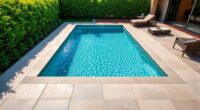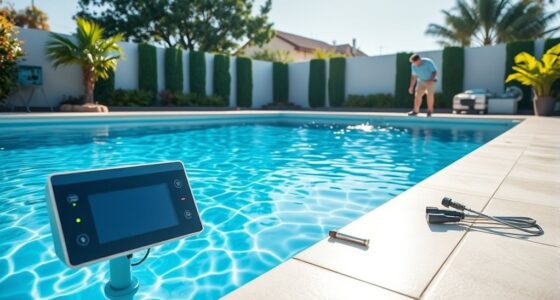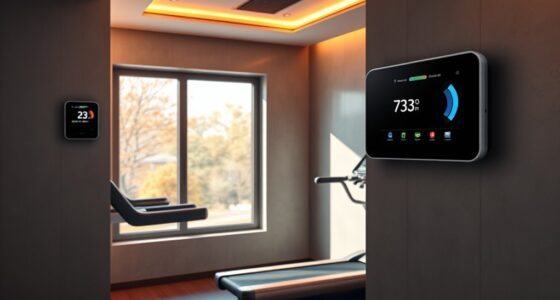To keep your pool crystal-clear, focus on understanding basic chemistry—balance pH, alkalinity, and sanitizer levels regularly. Test your water weekly with reliable strips or kits, aiming for a pH of 7.2–7.6 and sanitizer levels of 1–3 ppm. Maintain proper chemical balance, add chlorine consistently, and shock the pool when needed. By mastering these fundamentals, you’ll ensure safe, inviting water. Keep going to discover more tips for trouble-free pool care.
Key Takeaways
- Regularly test water pH (7.2–7.6) and alkalinity (80–120 ppm) to maintain clarity and prevent issues.
- Keep chlorine levels between 1-3 ppm for effective sanitation and prevent algae growth.
- Use proper chemicals to balance pH and alkalinity, adjusting promptly as needed.
- Regularly shock the pool to eliminate contaminants and maintain crystal-clear water.
- Follow manufacturer instructions and record test results weekly for consistent water quality.
Understanding Basic Pool Chemistry
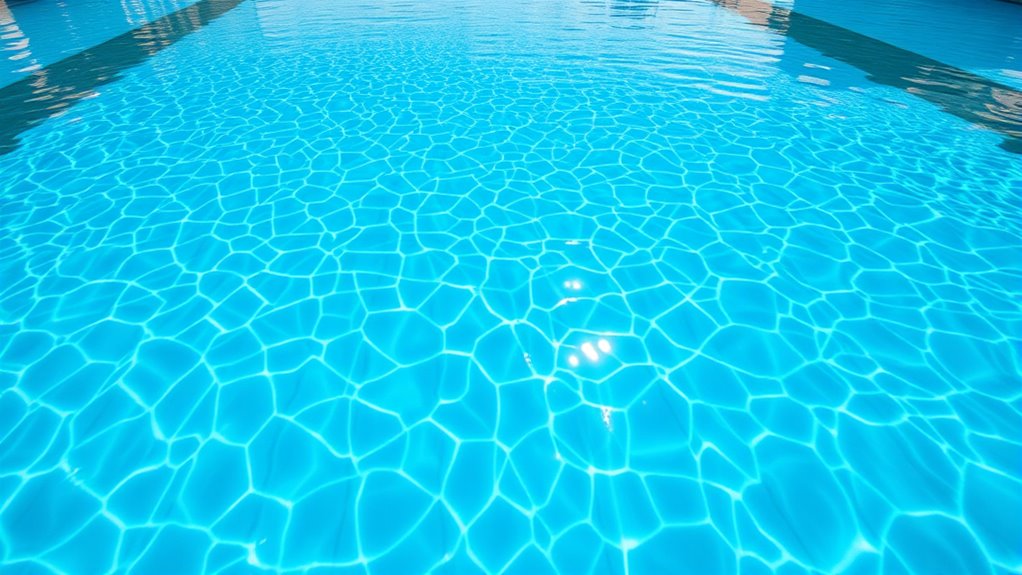
Understanding basic pool chemistry is essential to keeping your pool clean, safe, and inviting. When you grasp how water interacts with chemicals and environmental factors, you can better maintain clear, balanced water. Your goal is to control pH levels, which affect how well sanitizers work and prevent issues like algae growth or skin irritation. You’ll also need to monitor water temperature, as it influences chemical effectiveness. Regular testing with simple test strips or kits helps you stay aware of your pool’s chemistry. By understanding these basics, you’ll know when to add chemicals or adjust pH to keep your water sparkling. Staying proactive and consistent with your chemistry checks will save you time, money, and frustration in the long run. Additionally, understanding the effects of chemical interactions can help prevent common problems like cloudiness or corrosion.
Key Chemicals Every Beginner Should Know
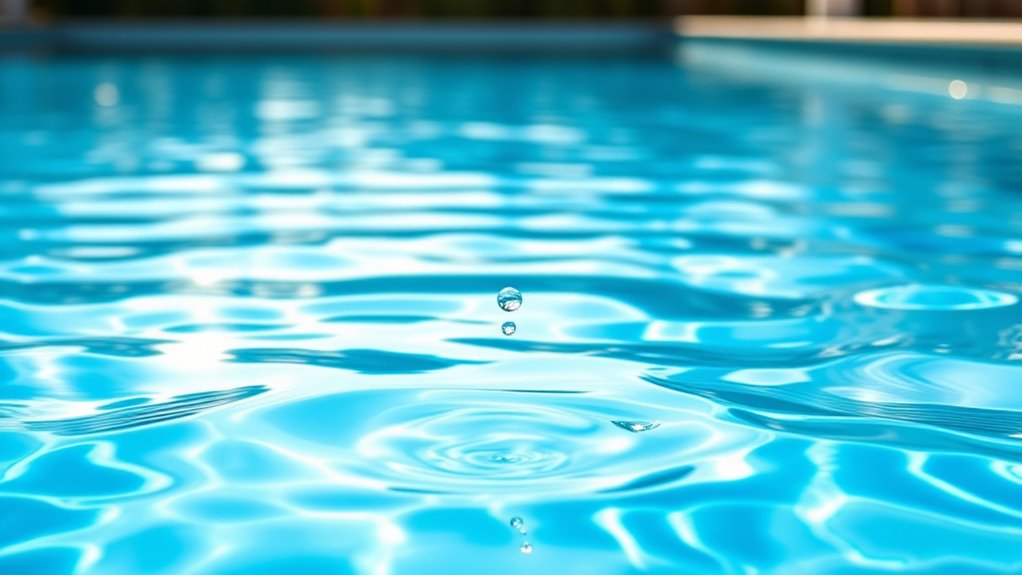
To keep your pool clean and safe, it’s essential to know the key chemicals involved in maintaining proper water chemistry. These chemicals ensure the water stays clear, balanced, and safe for swimming. The main chemicals you should focus on are chlorine, pH adjusters, alkalinity increasers, and stabilizers. Chlorine disinfects and kills bacteria, while pH adjusters maintain the water’s acidity or alkalinity. Alkalinity increasers help stabilize pH levels, preventing sudden changes. Stabilizers protect chlorine from sunlight breakdown, extending its effectiveness. Here’s a quick overview:
| Chemical | Purpose |
|---|---|
| Chlorine | Disinfects and sanitizes |
| pH Adjusters | Balance acidity/alkalinity |
| Alkalinity Increaser | Stabilizes pH levels |
| Stabilizer (cyanuric acid) | Protects chlorine from UV |
Maintaining proper levels of these chemicals is crucial for water quality and long-term pool health.
How to Test Your Pool Water Effectively

Testing your pool water accurately is the first step to maintaining a safe and healthy swimming environment. Use a reliable test kit or test strips designed for pools. Dip the strip into the water or follow the kit instructions carefully, ensuring the sample is taken from mid-depth, away from skimmers or inlets. Keep the strip in the water for the specified time, then compare the colors to the provided chart promptly. Record your results and check key parameters like chlorine, pH, and alkalinity. Regular testing—at least once a week—is essential for early detection of imbalances. Always follow the manufacturer’s instructions precisely to avoid inaccurate readings. Literary humor can serve as a reminder that consistent testing helps you keep your pool water safe, clear, and inviting for everyone.
Maintaining Proper Ph and Alkalinity Levels
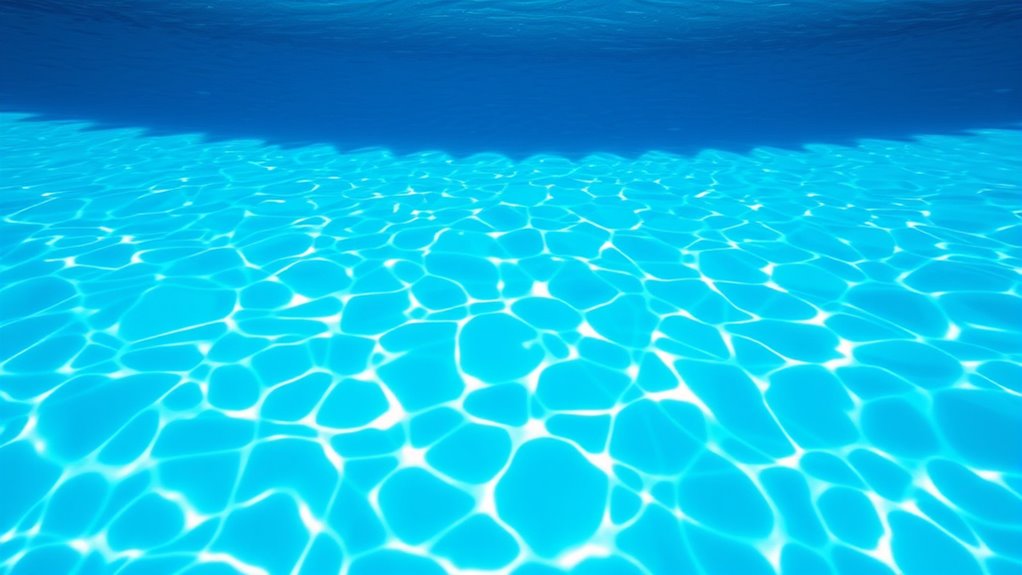
Keeping your pool’s pH and alkalinity balanced is essential for clear, safe water. You should check the pH regularly and make adjustments to prevent water from becoming too acidic or basic. Properly maintaining these levels helps avoid water imbalance and keeps your pool in top condition.
Monitoring Ph Regularly
Have you ever wondered why your pool’s water feels just right or turns cloudy unexpectedly? Regularly monitoring your pH levels helps keep your pool balanced and safe. To do this effectively:
- Test your water at least twice a week with a reliable kit.
- Record your readings to track trends over time.
- Adjust your chemicals promptly if pH drifts outside the ideal range of 7.2–7.6.
- Incorporate vertical storage solutions to organize your testing supplies and chemicals efficiently.
Adjusting Alkalinity Levels
Since alkalinity helps buffer your pool water against pH fluctuations, maintaining the right level is essential for a balanced and comfortable swimming environment. If alkalinity is too low, your water becomes more prone to pH swings, leading to cloudy water and corrosion. If it’s too high, pH adjustments become difficult, and scale can form. To adjust alkalinity, test your water using a reliable kit. If levels are low (below 80 ppm), add alkalinity increaser (usually sodium bicarbonate). If levels are high (above 120 ppm), dilute your pool water with fresh water or use a pH reducer. Always follow the manufacturer’s instructions for dosing. After adding chemicals, re-test after a few hours and adjust as needed to keep alkalinity within the ideal range. Understanding the pH and alkalinity relationship is crucial for maintaining water clarity and preventing equipment damage.
Preventing Water Imbalance
To prevent water imbalance, you need to actively monitor and maintain your pool’s pH and alkalinity levels regularly. Consistent testing helps catch issues early before they cause problems like cloudy water or equipment damage. Here are three key steps:
- Test your water at least twice a week using a reliable test kit.
- Adjust pH levels to stay between 7.2 and 7.6, adding pH increaser or decreaser as needed.
- Maintain alkalinity between 80-120 ppm by adding alkalinity increaser if levels drop.
Chlorine and Sanitizer Practices for Clear Water

Maintaining clear water in your pool heavily depends on proper chlorine and sanitizer practices. You need to regularly test your water to guarantee sanitizer levels stay within the recommended range, usually between 1-3 ppm for chlorine. If levels are too low, bacteria and algae can thrive, clouding your water. Conversely, too much sanitizer can cause skin irritation and other issues. To keep things balanced, add chlorine or sanitizer consistently, especially after heavy use or rain. Use appropriate methods like liquid, tablets, or granular chlorine, and follow manufacturer instructions. Shocking your pool periodically also helps eliminate contaminants. By maintaining steady sanitizer levels, you ensure your water remains clear, safe, and inviting for every swim. Proper divorce statistics and regional legal resources highlight the importance of accurate information and professional guidance to navigate complex situations effectively.
Tips for Regular Pool Maintenance and Troubleshooting

Consistent pool maintenance is key to keeping your water sparkling and safe. To stay on top of things, follow these simple tips:
- Test your water regularly – Use test strips or a kit weekly to monitor pH, chlorine, and alkalinity levels.
- Keep filters clean – Check and clean filters at least once a month to ensure proper circulation and filtration.
- Address issues promptly – If you notice cloudy water, algae, or strange odors, test your water and adjust chemicals accordingly.
Frequently Asked Questions
How Often Should I Completely Drain and Refill My Pool?
You should drain and refill your pool every 1 to 2 years, depending on usage and water quality. Regularly testing and balancing chemicals can extend the time between drainings. If you notice persistent cloudy water, algae growth, or unmanageable chemical levels, it’s time for a complete drain and refill. Proper maintenance keeps your pool clean, safe, and inviting, ensuring you enjoy crystal-clear water all year round.
Can Natural Alternatives Replace Chemical Sanitizers Safely?
You can consider natural alternatives like mineral systems or UV sterilizers, but they might not replace chemical sanitizers entirely. These options can reduce chemical use and still keep your pool safe, yet they often require precise maintenance and may not eliminate all bacteria or algae. For total safety and clarity, combining natural methods with minimal chemicals is usually the best approach, ensuring your water stays clean and healthy.
What Are the Signs of a Failing Pool Filtration System?
You’ll notice your pool filtration system is failing if the water looks cloudy or murky, indicating poor filtration. You might also see debris accumulating on the bottom or walls, and your pump may make unusual noises or stop running efficiently. Reduced water flow and lingering odors are signs too. Regularly check pressure gauges; if they’re high or fluctuate wildly, it’s a clear sign you need to inspect or replace your filter to keep your pool clean.
How Does Water Temperature Affect Chemical Balance?
You’ll notice that higher water temperatures cause chemicals to react more quickly, often leading to faster pH changes and increased algae growth. Conversely, cooler water slows these reactions, making it harder to maintain proper chemical balance. To keep your pool crystal clear, regularly test your water and adjust chemicals accordingly, especially when temperatures fluctuate. Proper balancing ensures safe, comfortable swimming and prevents issues caused by temperature-related chemical instability.
Are There Eco-Friendly Options for Pool Maintenance?
Think of eco-friendly pool maintenance as tending a lush garden—you want to nurture it gently. You can use biodegradable algaecides, mineral sanitizers, or saltwater systems that cut down on harsh chemicals. Regular filtration and natural enzymes keep your pool sparkling without harming the environment. With these gentle options, you enjoy pristine water while protecting our planet—a win-win for your pool and Mother Earth.
Conclusion
With a little attention, your pool can become a shimmering oasis, reflecting sunlight like a crystal mirror. By mastering basic chemistry, testing regularly, and keeping chemicals balanced, you’ll create a pristine haven that invites effortless relaxation. Imagine diving into water so clear it feels like swimming through liquid glass—every moment feels luxurious. Stay vigilant with maintenance, and your endless pool will remain a sparkling retreat, welcoming you home to serenity whenever you desire.


